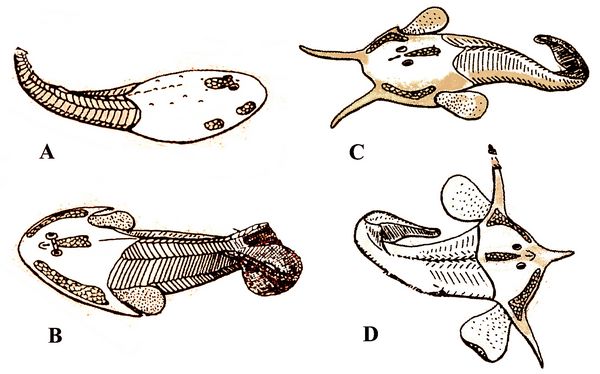Athena Review Image Archive ™
Osteostracci

Osteostracci: A) Tremataspis, B) Zenaspis, C) Tauraspis, D) Hoelaspis (after Janvier 1997)
Osteostracci
(“bone shields”) were a class of jawless fish (agnathans) which
included about 200 species, living from the Early Silurian to the Late
Devonian period (ca. 430-370 mya). The bodies of osteostracans were
covered with large, diamond-shaped scales. Sizes ranged from 1 m to 4
cm., with most osteostracans about 20 to 40 cm in length. Most have a
characteristic horseshoe-shaped skull, covered with a shield of dermal
bone.
On the dorsal or top surface of the head are closely-set
eyes, a pineal foramen, and a keyhole-shaped nasohypophysial opening.
An example is the small-sized Mimetaspis concordis,
found in an Early Devonian strata exposed along the Dneister River in
the Ukraine In addition, there are peculiar depressions of the
braincase, covered with loose platelets of dermal bone, regarded as
either sense organs or electric organs.
Some species also have hornlike processes protruding from the head shield. The mouth and gill openings are on the lower or ventral side of the head. Osteostracans also have two large, pad-shaped dorsal fins (reduced to one or none in the more advanced forms). These dorsal fins contained muscles, and were attached to the headshield (Janvier 1997).
Most osteostracans lived in marginal, marine environments. Their horseshoe-shaped headshield suggests a benthic or bottom-feeding mode of life. They are most diverse in the Early Devonian, becoming rare in the Middle and Late Devonian. Osteostracans are widely distributed in North America, Europe, Siberia, and Central Asia. Subclasses include the Zenaspidida, Benneviaspidida, Kiearaspidida, and Thyestiida.
The figure shows Osteostracans from the clade Cornuata. A) The thyestid Tremataspis, who lacks paired fins, perhaps due to specialized burrowing habits. B) The zenaspidid Zenaspis, a typical form with a massive headshield. C. The benneviaspidid Tauraspis, with double head shield projections. D) The benneviaspidid Hoelaspis, with triple headshield projections (Janvier 1997).
References:
Janvier, P. 1997. Arandaspida. The Tree of Life Web Project.
Janvier, P. 1998. Early vertebrates. Oxford, New York: Oxford Univ. Press, 1998.
Copyright © 1996-2020 Rust Family Foundation (All Rights Reserved).